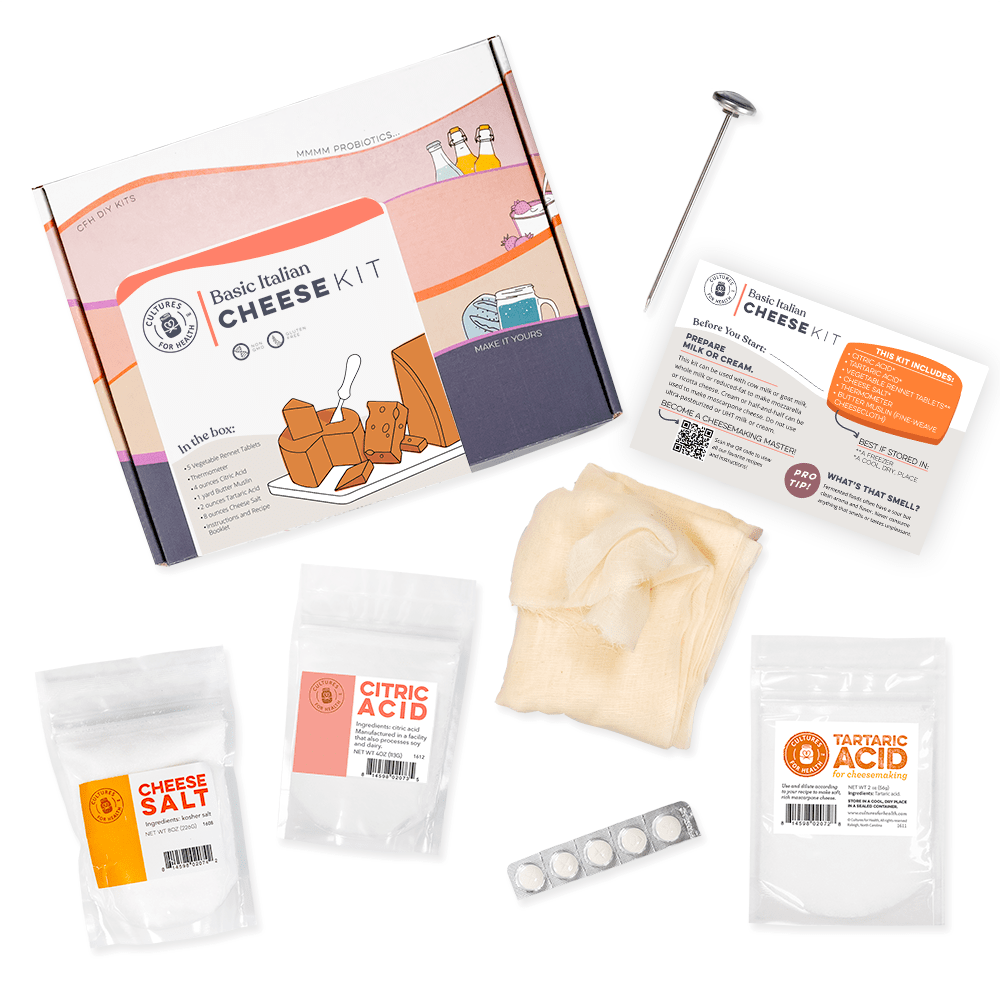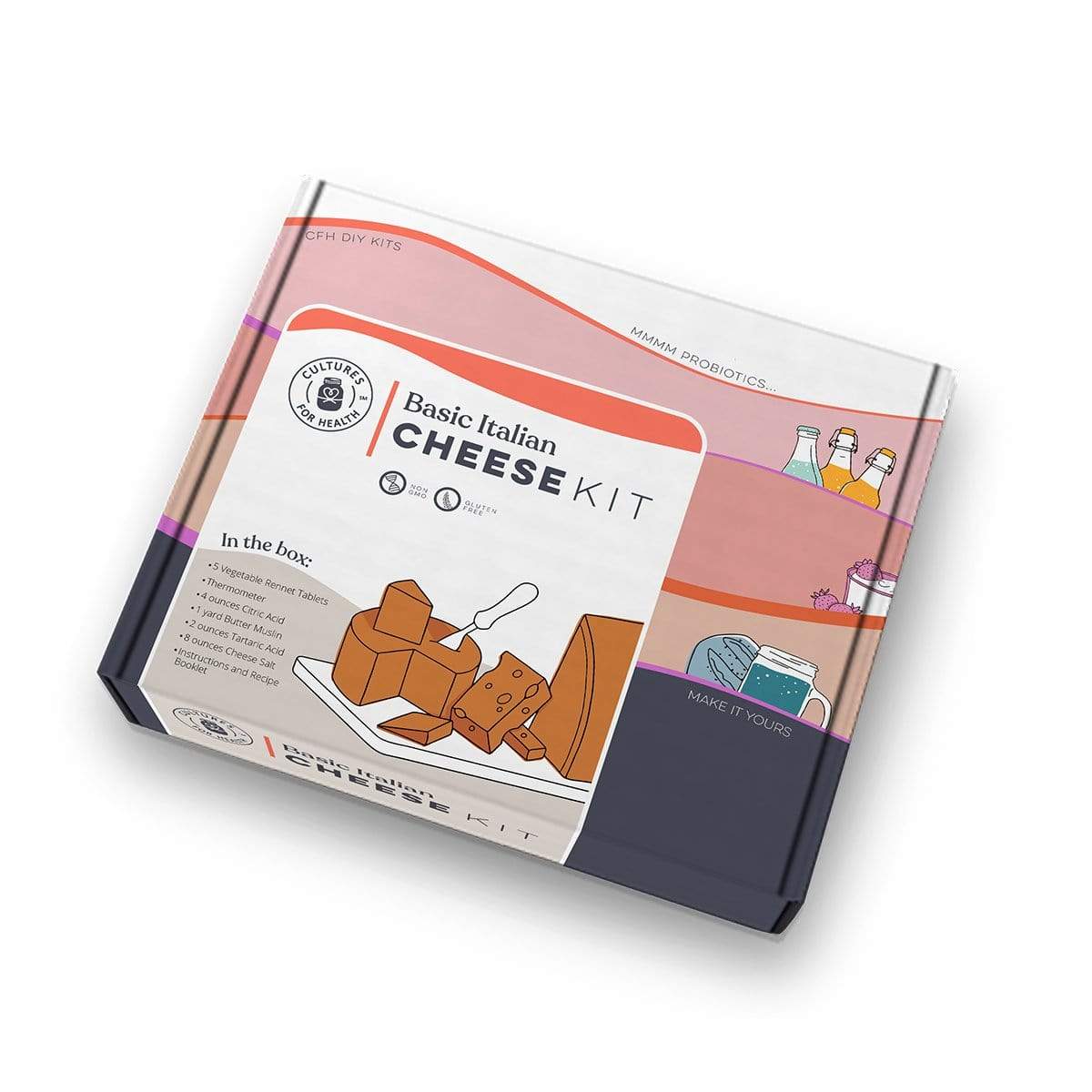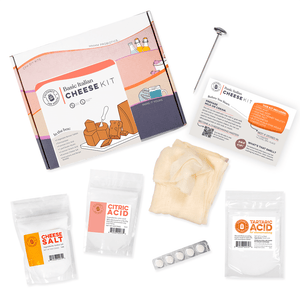Cheese making is an ancient process of culturing milk. While it is possible to make cheese without a cheese culture (take these acid cheeses for instance), using a cheese culture helps good bacteria in the milk flourish and leads to a more fully developed flavor in the final cheese.
When diving into cheese making for the first time, you may be overwhelmed by the variety of cheese cultures to choose from. Understanding what a cheese culture is, how it works, and how to choose one can help home cheese making seem less daunting.
Most cheese recipes take the guesswork out by listing the specific cheese culture needed, but when you are ready to experiment a bit or create your own recipe, this understanding of cheese cultures will also come in handy.
Download our Cheesemaking Guide and Recipe today to learn about cheese starter cultures. You will not only learn how to make delicious cheese, but you will also learn about the health benefits of using cheese starter cultures in your recipes.
START MAKING CHEESE AT HOME WITH CULTURES FOR HEALTH!
WHAT IS A CHEESE CULTURE?
A cheese culture is a group of specific bacteria strains put together (usually by a culture company) for making a specific cheese.
Most cheese cultures work in similar way but are classified based on the temperature at which they work.
Outside of temperature classifications, cheese cultures are also differentiated by the strains of bacteria they contain. The type of bacteria strains and ratio of each strain in a cheese culture will vary depending on what cheese it is intended to be used to make.
HOW DO CHEESE CULTURES WORK?
All cultures do the same basic work. Cheese cultures rapidly raise the acidity of milk by consuming the lactose (milk sugar) present and converting it into lactic acid. This disables the already-present bacteria and helps the rennet (or coagulant being used) to set the cheese.
Starter cultures also aid in development and preservation of the flavor and body of the cheese during cheese making and afterwards, in the aging process.
CLASSIFYING CHEESE CULTURES BY TEMPERATURE
Cheese cultures are often grouped by the temperature range at which they work.
- Mesophilic means medium-loving, indicating that a mesophilic culture will propagate best at temperatures up to 90ºF.
- Thermophilic means heat-loving. This type of culture is added to milk heated to higher temperatures.
Within each of these temperature categories there are cheese cultures made up of different bacteria strains in different ratios. It is these different combinations and ratios that yield different cheeses.
MESOPHILIC CHEESE STARTER CULTURES
Specific Cheese Starter Cultures
There are several cheese cultures designed with a blend of bacteria for making one specific cheese. These are a good starting point for anyone that isn't ready to experiment and just wants a straightforward process for making cheese. Each of these starter cultures includes complete instructions for use and some even include the rennet!
Basic Italian Cheese Making Kit
General Cheese Starter Cultures
There are also several cultures that have a more broad usage. These cultures contain several packets, so you can experiment with a variety of recipes from just one box of culture. Always consult your recipe, as other ingredients may be required for certain types of cheese.
- Fresh Cheese Culture is an aromatic mesophilic culture used in producing soft cheeses such as Cottage Cheese, Neufchatel, Chevre. It can also be used as the culture in flavorful aged cheese varieties such as Blue Cheese and Baby Swiss.
- Using the Mesophilic Direct-Set Cheese Culture (MA11), you can make a variety of flavorful semi-soft and fresh cheeses from the comfort of your home, including Cheddar Cheese, Colby, Monterey Jack, homemade Feta cheese, Chèvre, and more.
- Mesophilic Aromatic Type B is another versatile cheese culture with a buttery flavor. It is used for making sour cream and cultured butter, soft cheeses such as Goat Cheese, Cream Cheese and Cottage Cheese, and other specialty cheeses such as Havarti and Camembert.
- Flora Danica Mesophilic Starter Culture also gives cheeses a buttery flavor. This culture is primarily used to make cheeses such as Gouda, Edam, Leerdam, Samsoe, and soft cheeses such as Lactic Cheeses, Camembert, and Blue Cheese.
- MM Series Starter Culture is used to make Brie, Camembert, Havarti, Gouda, Edam, Feta, Blue Cheese, Chevre, and other buttery, open-textured cheeses.
- MA 4000 Series Farmhouse Cheese Culture resembles the bacteria balance in raw milk and creates an open texture ideal for many cheeses including Caerphilly, Brin D’ Amour, and Roquefort.
- RA22 Cheese Culture is a fast acidifying culture used for traditional cheddar and similar cheeses.
THERMOPHILIC CHEESE STARTER CULTURES
Thermophilic cheese cultures are used to make a variety of cheeses, sometimes in conjunction with a mesophilic culture.
- Thermophilic Direct-Set Starter Culture (TA 61) is used for making hard cheeses such as Parmesan, Romano, Provolone, Mozzarella, Emmental/Swiss.
- Thermo B Cheese Culture is used for making Italian-Style Mozzarella, Parmesan, Romano, Provolone, other Italian cheeses.
- Thermo C Cheese Culture is also used for making Italian cheeses. It is also well suited to making farmstead type cheeses, such as Emmentaler, Gruyere, Swiss, and Romano.
-
Propioni Bacteria is used primarily for the eye formation, aroma, and flavor production in Swiss type cheeses.
HOW TO CHOOSE A CHEESE CULTURE
Pick a Recipe, Then a Culture
If you're new to cheese making, the number of cheese cultures available can be overwhelming to say the least. Rather than trying to pick out a cheese culture and then find a recipe you can use it in, it's much simpler to first decide what type of cheese you want to make and then use the cheese culture listed in that cheese recipe.
There are a handful of easy cheese recipes that are great for beginners (some don't even require a cheese culture!) Once you decide on a recipe, check the cheese culture listed in the cheese ingredients list.
Multiple Culture Options in a Recipe? Use Your Package Preference
Some recipes may give you the option of using a few different cheese cultures. Most often the difference between these cultures is how they are packaged. For instance, our recipe for Edam Boule requires either 2 packets of the Mesophilic Starter Culture or 1/4 tsp. of a bulk mesophilic starter.
Each box of the Fresh Cheese Starter Culture, Mesophilic Starter Culture, and Thermophilic Starter Culture contains 8 packets of direct-set starter culture. You can use these on a per packet basis according to your recipe.
Other starter cultures come in a bulk packet and need to be measured out according to the recipe.
When a recipe gives you the option of using packets or bulk starter, which one you choose really just depends on your personal preference. Either will make delicious cheese!
CHEESE MAKING KITS
If you're uncertain about which cheese culture you want to work with, you might want to give a cheese making kit a try. They're a great project and we've simplified the process.
These kits come with everything you need to make homemade cheese - all you have to provide is the milk! From mozzarella to fresh cheese there are options for all experience levels.
- Paneer & Queso Blanco Cheese Making Kit (uses Citric Acid for cheese making)
- Mozzarella and Ricotta Cheese Making Kit (uses Citric Acid and Vegetable Rennet Tablets for cheese making)
- Basic Italian Cheese Making Kit (uses Citric Acid and Tartaric Acid for cheese making)
- Goat Cheese Making Kit (uses Mesophilic Direct-Set Starter Culture, Liquid Vegetable Rennet, and Calcium Choride for cheese making)
- Fresh Cheese Making Kit (uses Mesophilic Direct-Set Starter Culture, Fresh Cheese Starter Culture, Liquid Vegetable Rennet, and Calcium Choride for cheese making)
MOLDS USED IN CHEESEMAKING
Molds are responsible for giving some cheeses their specific flavor and texture. They are usually applied to the outside of the cheese where they form a crust.
- Penicillium Camemberti white mold spores are used for making Camembert and Brie cheeses and are essential in the ripening process of cheeses with white surface mold.
-
Penicillium Roqueforti mold spores are used for making Blue Cheese and are essential in the ripening process.
Interested in making your cheese at home? Download our Cheesemaking Guide and Recipe today to learn about cheese starter cultures.






















